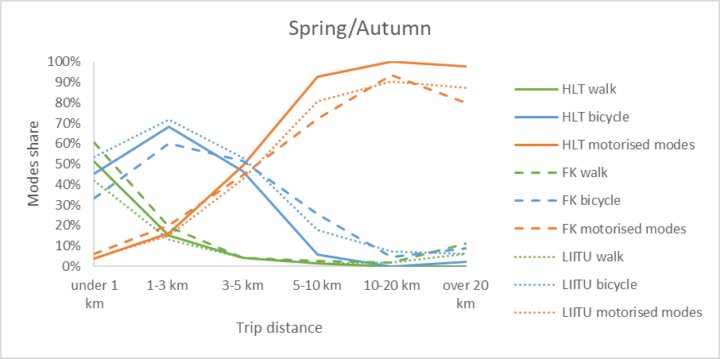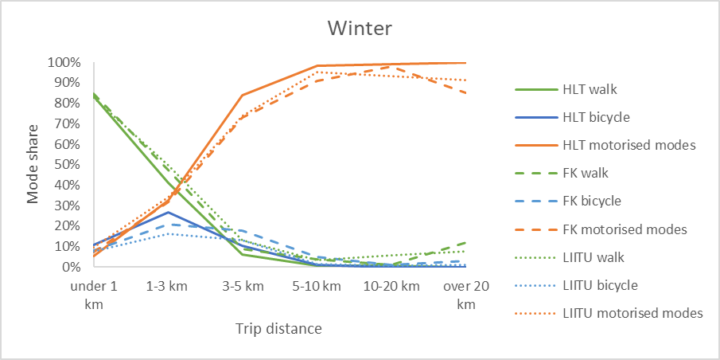BLOG
How often do Finnish school children cycle to school – and how can we nudge school kids to cycle more? The cycling of school children and other means of active travel in Finland have been in the object of several studies (see e.g. sources [1] and [2]). In addition, the National Travel Survey or HLT 2016 [3] also provides information on the modes of travel used in Finland.
The objective of the CLIMATE NUDGE project is to encourage active travel and especially cycling using nudges. Nudges are small changes in the environment where we make our everyday choices. To know which nudges are most effective, we first need information on the current situation. For this reason, we have analysed data from the Finnish National Travel Survey (NTS) with regard to children’s school trips and especially travel to school by bicycle.
The analysis included all the NTS data collected for school children. This data comprised of 3781 observations from 6–15-year-old primary and secondary school pupils. The results of the analysis were compared to the 2020 and 2021 “Fiksusti kouluun” or FK survey [1] and to the results of the LIITU research project [2]. (“Fiksusti kouluun” might be translated as “Smartly to School”.)
Cycling decreases significantly in winter
All three sources tell a similar tale of cycling on trips to school. The mode share of cycling grows following a bell-like curve until trip distances reach 2–3 kilometres, after which cycling starts to decrease and dwindles to almost nothing around ten kilometres. The amount of cycling depends, however, strongly on the season. The mode share of walking decreases as travel distances increase and gets close to zero when trip distances reach five kilometres.
There are also differences between the sources. The FK survey targeted secondary school children more than the NTS. These teenagers cycle more on medium-length 3–5-kilometre trips than younger children. The NTS data also includes more kids from the Oulu region, where people typically cycle more than elsewhere in Finland.


Travel to school by Finnish school children according to HLT (national travel survey), FK and LIITU data. The HLT data for spring/autumn includes observations for May, June, August, September and October, and the data for winter covers observations in November, December, January, February and March. Motorised modes include travel by private car, school transport, public transport (including rail) and mopeds.
In the context of the CLIMATE NUDGE project, it is interesting to note that the use of motorised transport by school kids is fairly limited on short trips compared to commuters. Reliance on active travel could, however, further increase on shorter trips to school. The aim of the FK programme is to reduce car use on 0–2-kilometre trips as much as possible and to pay particular attention to parents accompanying their children to school by car on these trips, especially in winter.
The mode share of cycling is much higher in spring and autumn than in the winter. Cycling is luckily partly replaced by walking, especially on trips less that are less than three kilometres long. The share of car use does, however, start to increase for trips longer than one kilometre. Encouraging travel by bicycle in the winter would therefore be one of the best ways to increase active travel. Main cycling routes to school need to be prioritised in terms of winter maintenance, and bicycle parking areas should be kept clear of snow. Bicycle storage facilities adapted to winter conditions should also be provided.
Girls cycle less than boys in Finland
Another interesting observation stemming from the analysis results is that there are differences in how girls and boys cycle. Girls walk and also use more motorised means of transport than boys, but they cycle less. In addition, the decrease in cycling in the winter is more marked for girls than for boys. It would be interesting to closer study the factors impacting the cycling behaviour of girls. In this way we might also better encourage girls – using nudges or other means – to cycle more on trips under five kilometres instead of relying on car-based travel.
Sources (in Finnish)
[1] Joonas Niemi, Harto Hakonen, Jouni Kallio, Heidi Lindfors and Tuija Tammelin: Koulumatkojen kulkutapaseuranta, syyskuu 2020, helmikuu 2021 ja toukokuu 2021, Fiksusti kouluun -ohjelma. Tulostiivistelmä. Likes 2021.
[2] Sami Kokko and Leena Martin (eds.): Lasten ja nuorten liikuntakäyttäytyminen Suomessa – LIITU-tutkimuksen tuloksia 2018. Valtion Liikuntaneuvosto 2019.
[3] Finnish National Travel Survey 2016 (in Finnish). Henkilöliikennetutkimus 2016 – Suomalaisten liikkuminen. Liikenneviraston tilastoja 1/2018.
